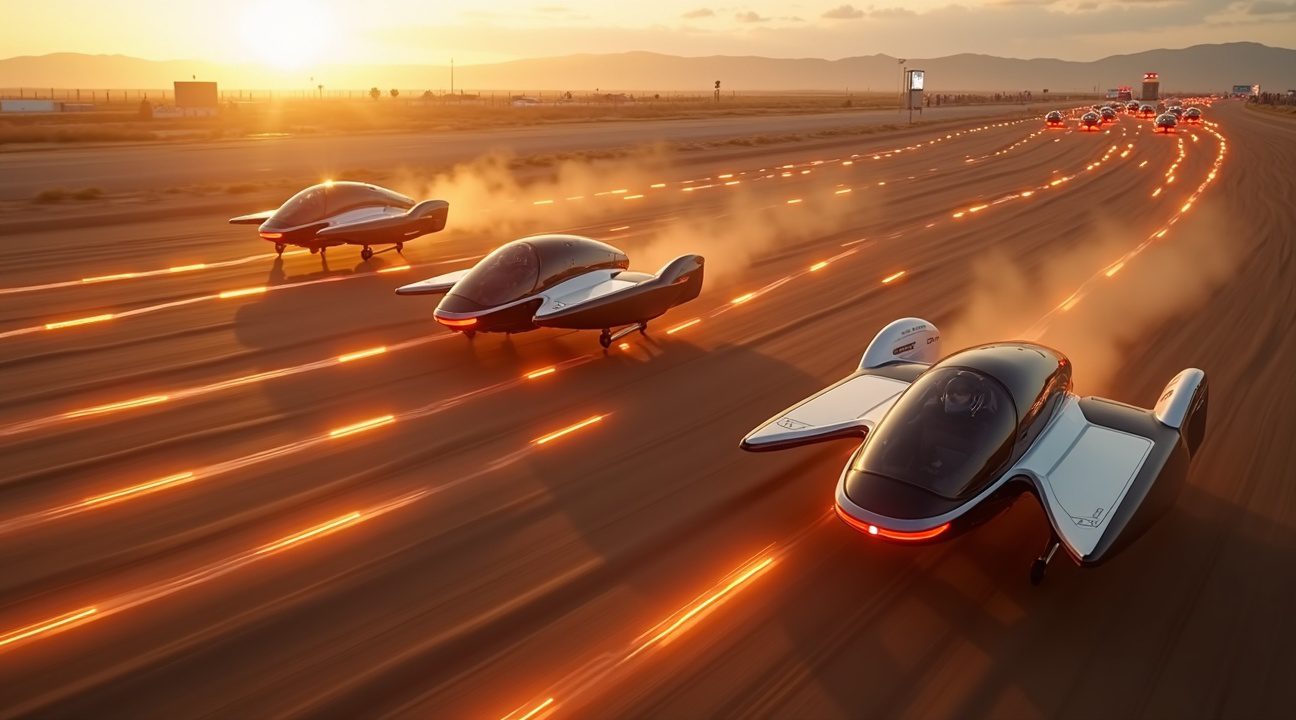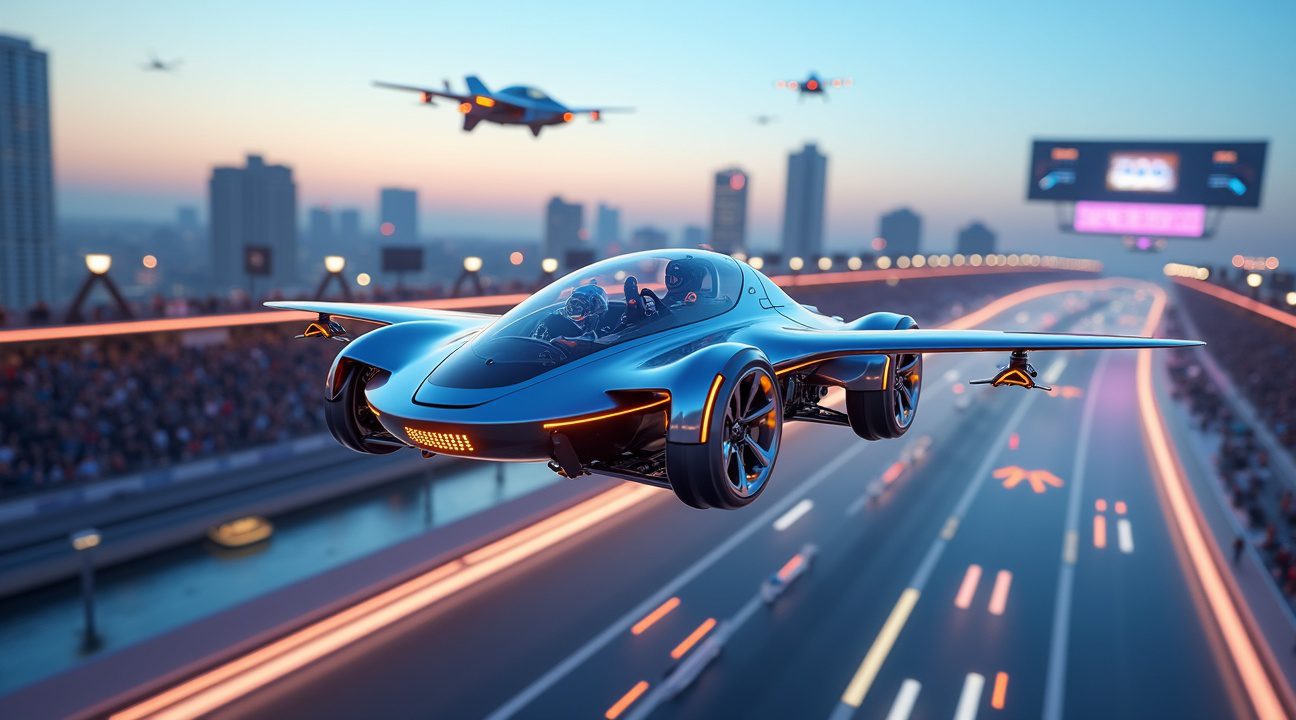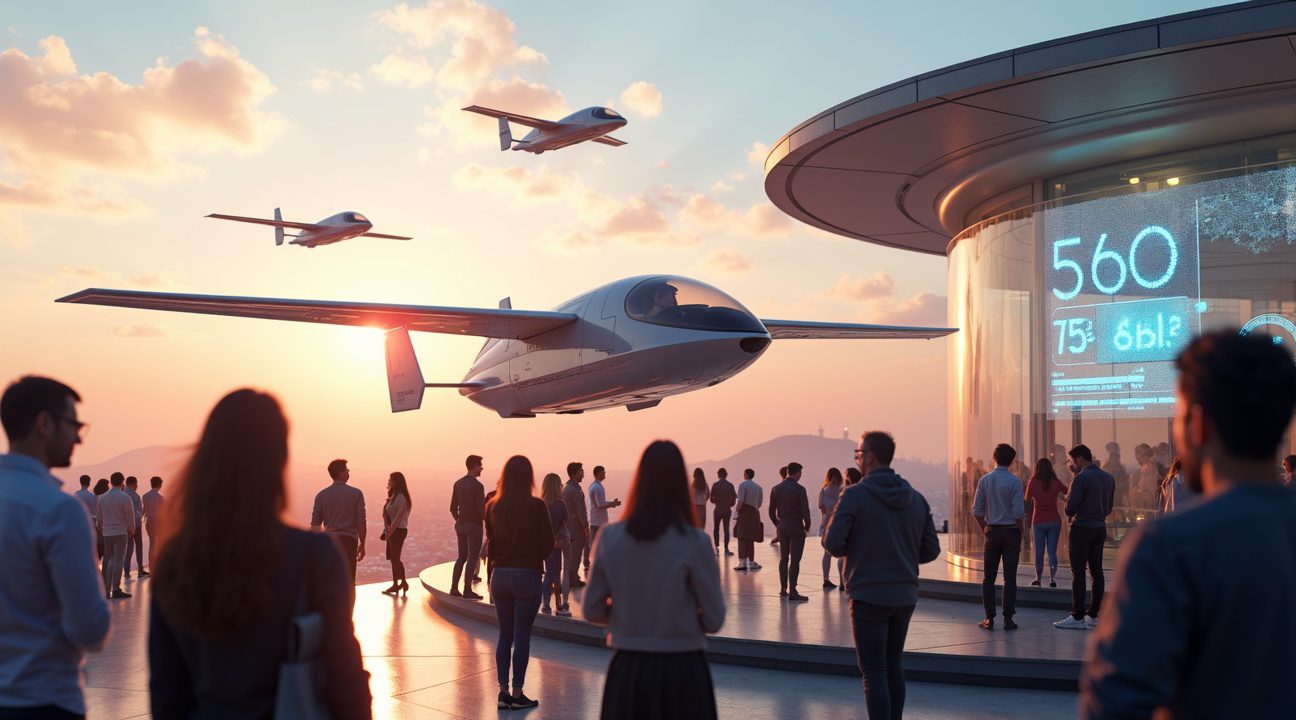The Jetson Air Games created aviation history at UP.Summit 2025 as the globe’s first competitive flying car racing event.
Four Jetson ONE eVTOLs carried real pilots through aerial pylon races in head-to-head competition. This breakthrough demonstration represents a crucial milestone in personal aviation, proving that electric vertical takeoff and landing technology has advanced from experimental prototypes to vehicles capable of supporting competitive sports applications.
Key Takeaways
- Historic First: The Jetson Air Games featured the globe’s first four-ship formation flight with pilots inside eVTOLs, followed by competitive pylon racing approximately 20 feet above ground.
- Market Success: Jetson has secured nearly 550 unit orders worth $75 million in future sales, demonstrating strong commercial demand for personal aviation technology.
- Advanced Safety Systems: The Jetson ONE incorporates multiple redundant safety features including eight-motor configuration, ballistic parachute deployment, and radar-assisted landing systems.
- Accessible Technology: The aircraft requires no pilot’s license to operate in the United States and costs $128,000, making personal aviation more accessible to enthusiasts and early adopters.
- Industry Leadership: While competitors focus on autonomous passenger transport, Jetson has carved a unique position by prioritizing piloted racing vehicles that deliver genuine aerial competition.
To learn more about Jetson and their revolutionary aircraft, visit the official Jetson Aero website.
Four Flying Cars Battle Head-to-Head in Historic Sky Race at UP.Summit 2025
The aviation industry witnessed history at UP.Summit 2025 when Jetson launched the first-ever Jetson Air Games, bringing flying car racing into reality. Four Jetson ONE eVTOLs took to the skies in the inaugural event, demonstrating that personal aviation sports have officially arrived.
This groundbreaking event featured the world’s first four-ship formation flight with pilots inside eVTOLs, followed by an intense high-speed pylon race. The aircraft maneuvered approximately 20 feet above ground, showcasing remarkable speed and agility as they navigated around strategically placed pylons. Unlike remote-controlled demonstrations, real pilots controlled each vehicle, adding authentic human skill and risk to the competition.
Jetson Founder and CTO Tomasz Patan personally piloted segments of both the formation flight and solo racing portions, demonstrating the technology’s safety and performance capabilities in front of a live audience of potential investors and aviation enthusiasts. His participation underscored the company’s confidence in their aircraft’s reliability and handling characteristics.
The Birth of Aerial Racing Sports
The Jetson Air Games represents the company’s ambitious vision to establish what they call the “Formula One of the skies.” This marks the first racing series where actual pilots control eVTOLs in competitive aerial combat, distinguishing it from drone racing or static demonstrations that typically characterize aviation showcases.
The event’s significance extends beyond entertainment value. It demonstrates that eVTOL technology has matured enough to support competitive sports applications while maintaining safety standards. The precise maneuvering required for pylon racing tests:
- Aircraft responsiveness
- Pilot skill
- Vehicle durability under demanding conditions
Each Jetson ONE showcased during the games represents thousands of engineering hours dedicated to creating stable, responsive flight platforms. The aircraft’s ability to maintain formation flight and execute rapid directional changes around pylons validates the design’s effectiveness for both recreational and competitive applications.
The success of this inaugural event positions Jetson at the forefront of a potentially massive new sporting industry. As space exploration continues advancing, aerial racing could become the stepping stone that bridges traditional motorsports with future aerospace competitions.
The timing coincides perfectly with growing public interest in personal aviation, where investors and consumers increasingly view eVTOLs as practical transportation solutions rather than science fiction concepts. This demonstration proves that flying cars have evolved from experimental prototypes to vehicles capable of supporting competitive racing leagues.

Jetson ONE Specifications: The Racing Car Built for the Sky
The Jetson ONE represents a breakthrough in personal aviation, demonstrating that flying car technology has evolved from science fiction into racing reality. This single-seat electric vertical take-off and landing vehicle combines aluminum and carbon fiber construction with eight electric motors to deliver an extraordinary flying experience that requires no specialized pilot training.
Technical Performance and Design
Weighing just 54 kilograms (120 pounds), the Jetson ONE achieves remarkable agility through its lightweight construction. The aircraft reaches a top speed of 102 kilometers per hour (63 mph) and climbs to a maximum altitude of 457 meters (1,500 feet). Flight time maxes out at 20 minutes per charge, providing sufficient duration for competitive racing scenarios and recreational flights.
Eight electric motors power this innovative aircraft, distributing thrust across multiple points for enhanced stability and safety. The aluminum and carbon fiber frame strikes an optimal balance between strength and weight, enabling the rapid climbing and precise maneuvering that spectators witnessed during the Air Games competitions.
Accessibility and Market Position
Perhaps most remarkably, operators don’t need a pilot’s license to fly the Jetson ONE in the United States. This regulatory advantage opens personal aviation to a broader audience, making the technology accessible to racing enthusiasts and adventure seekers without extensive aviation backgrounds.
The aircraft carries a price tag of $128,000, though this increases to $148,000 starting November 3, 2025. While substantial, this pricing positions the Jetson ONE within reach of serious aviation enthusiasts and early adopters who want to experience the cutting edge of aerospace innovation.
During the Air Games, drivers demonstrated the aircraft’s capabilities through tight pylon formations, showcasing the precision control possible with the Jetson ONE’s design. The racing format highlighted several key performance characteristics that set this vehicle apart from traditional aircraft:
- Rapid vertical climbing ability that allows for dramatic course navigation
- Precise horizontal maneuvering for threading between racing pylons
- Stable flight characteristics that enable close-formation racing
- Quick response controls that adapt to pilot inputs without lag
- Consistent performance across varying flight conditions
The ease of operation became evident as drivers navigated complex racing courses without requiring years of flight training. This accessibility factor distinguishes the Jetson ONE from conventional aircraft and positions it as a gateway vehicle for newcomers to personal aviation.
Engineers designed the aircraft’s control systems to be intuitive, drawing parallels to automotive controls rather than traditional aviation interfaces. This approach reduces the learning curve and allows drivers to focus on racing strategy rather than struggling with complex flight mechanics.
The Air Games demonstrated that electric vertical take-off technology has matured enough to support competitive racing formats. The consistent performance across multiple aircraft during racing events proved the reliability of the eight-motor configuration and highlighted the potential for organized flying car competitions.
Flight testing during the games revealed the aircraft’s ability to maintain stable flight patterns even during aggressive maneuvering. Drivers pushed the vehicles through rapid direction changes and elevation adjustments while maintaining formation flying, proving the design’s suitability for both recreational use and competitive applications.
The 20-minute flight duration provides adequate time for racing heats while ensuring pilots can complete their courses with safety margins. This endurance specification reflects current battery technology limitations but offers sufficient performance for meaningful competitive events and training sessions.
The Jetson ONE’s combination of lightweight construction, intuitive controls, and regulatory accessibility creates a unique position in the emerging personal aviation market. The Air Games served as a proving ground for these specifications, demonstrating that the theoretical capabilities translate into real-world performance under racing conditions.
https://www.youtube.com/watch?v=aqk7aR6f_4s
Advanced Safety Systems Enable Public Racing Confidence
I’ve witnessed significant safety breakthroughs that make flying car racing accessible to broader audiences. Jetson’s approach centers on multiple redundant systems that work together to prevent accidents and protect pilots during competitive events.
The vehicle incorporates radar-sensing technology for automatic landings, which dramatically reduces human error during critical landing phases. This system actively monitors ground conditions and adjusts descent patterns to ensure smooth touchdowns, even when pilots experience fatigue or stress during extended racing sessions.
Critical Safety Features for Racing Applications
The safety architecture includes several key components designed for high-performance situations:
- Eight-motor configuration allowing continued safe operation with one motor failure
- Ballistic parachute system engineered for rapid deployment during emergencies
- Radar-based landing assistance that compensates for pilot error
- Redundant control systems maintaining flight stability under various conditions
The ballistic parachute represents a particularly crucial innovation for racing environments. Unlike traditional parachutes, this system deploys rapidly through explosive charges, creating immediate drag that brings the vehicle down safely even at low altitudes where conventional parachutes wouldn’t have time to open properly.
Motor redundancy addresses one of aviation’s most persistent challenges. I find it remarkable that these vehicles continue flying safely when seven of their eight motors remain operational. This design philosophy mirrors commercial aviation standards, where multiple engine failures rarely result in catastrophic outcomes.
The radar enhancement systems continuously scan the landing environment, providing real-time feedback that supports automatic adjustments during descent. These systems prove especially valuable during racing scenarios where pilots focus intensely on competition rather than standard landing protocols.
Safety innovations directly address historical public concerns about personal flying vehicles. Previous experimental aircraft often lacked comprehensive backup systems, creating justified skepticism about widespread adoption. Jetson’s multi-layered approach demonstrates how engineering solutions can overcome traditional barriers to public acceptance.
Racing applications push these safety systems harder than typical recreational use, creating valuable testing environments for future space exploration technologies. The demanding conditions of competitive flying reveal potential weaknesses that engineers can address before broader market deployment.
These safety advances support public adoption by demonstrating that flying vehicles can operate with reliability standards comparable to traditional aircraft. Racing events showcase system performance under extreme conditions, building confidence among potential users who might otherwise hesitate to embrace personal aviation technology.

Market Momentum: 550 Units Ordered Worth $75 Million in Future Sales
Jetson’s impressive commercial trajectory demonstrates the growing appetite for personal air mobility solutions. The company’s public orderbook has reached nearly 550 units, translating to $75 million in future sales commitments. This substantial financial backing validates the market’s confidence in flying car technology transitioning from concept to reality.
First Delivery Milestone and Market Validation
The milestone delivery to tech entrepreneur Palmer Luckey represents more than just a single transaction. Palmer’s high-profile status in the tech industry brings credibility to Jetson’s platform while demonstrating that sophisticated buyers see real value in the technology. His involvement signals to other potential customers that personal air mobility has moved beyond experimental phases into practical applications.
The UP.Summit showcase served as a critical turning point for the industry. Industry observers widely regard this event as the moment personal air mobility gained legitimate traction as both a sport and consumer product. Space exploration advancements have certainly captured public imagination, but Jetson’s approach brings that excitement down to earth in an accessible format.
Diverse Stakeholder Engagement
Jetson’s success stems from attracting a remarkably diverse audience that spans multiple demographics and interest groups. The company has successfully engaged several key constituencies:
- Families seeking innovative recreational experiences that combine technology with adventure
- Aviation experts who recognize the technical achievements and safety protocols
- Investors looking for opportunities in the rapidly expanding urban air mobility sector
- Technology enthusiasts drawn to the intersection of gaming and aviation
This broad appeal creates a sustainable foundation for growth beyond initial novelty purchases. Each group brings different motivations and spending power, reducing dependency on any single market segment.
Jetson’s strategic vision centers on redefining personal air mobility through dynamic aerial sports rather than positioning itself solely as a transportation company. This approach differentiates the brand from traditional aviation manufacturers and creates an entirely new category. The company’s planned competitive league structure adds another revenue stream while building community around the product.
Strong investor interest reflects confidence in both the technology and market positioning. Commercial space flights have proven that consumers will pay premium prices for transformative experiences. Jetson applies similar principles to personal aviation, creating excitement around controlled flight experiences that don’t require extensive pilot training.
The combination of proven demand, diverse market appeal, and clear differentiation strategy positions Jetson favorably for continued growth. Their orderbook momentum suggests the company has successfully identified and captured early adopters willing to invest in next-generation personal mobility solutions.

Jetson Leads Global eVTOL Racing While Competitors Focus on Autonomous Transport
I’ve watched the eVTOL industry evolve dramatically since NASA’s pioneering Puffin project began development in 2009, but Jetson’s recent air racing accomplishment stands out as truly exceptional. While most manufacturers concentrate on autonomous passenger transport, Jetson has carved a unique path by prioritizing piloted racing vehicles that deliver genuine head-to-head competition.
Major Players Pursue Different Paths in eVTOL Development
The competitive landscape reveals fascinating contrasts in strategic approaches. Australian Airspeeder has developed impressive ‘Speeders’ eVTOLs specifically for racing applications, yet they haven’t achieved actual races with onboard pilots. Their vehicles showcase remarkable engineering, but practical implementation remains elusive.
Meanwhile, established manufacturers focus heavily on commercial transportation solutions:
- Ehang from China secured mass production approval for autonomous taxi operations in 2024, emphasizing passenger safety over racing excitement
- Supernal, backed by Hyundai’s automotive expertise, plans air taxi testing programs beginning in 2025 with commercial service goals
- Honda applies decades of automotive and aerospace knowledge to develop reliable urban air mobility solutions
- Airbus leverages extensive aviation experience to create sophisticated autonomous transport systems
These companies represent billions in investment and years of research, yet none have accomplished what Jetson achieved with its flying car makes its debut at their inaugural Air Games. The distinction lies not just in technological capability, but in philosophical approach to eVTOL applications.
I find it remarkable that while competitors chase autonomous systems for safety and regulatory approval, Jetson embraces human piloting skills and competitive spirit. This decision requires tremendous confidence in vehicle design, pilot training, and operational safety protocols. Racing demands split-second responses, aggressive maneuvering, and performance margins that autonomous systems simply can’t replicate.
The timing coincides perfectly with growing public interest in commercial flights to space and advanced aviation technologies. Consumers witness space exploration achievements regularly, making eVTOL racing feel like a natural evolution in personal aviation entertainment.
Jetson’s breakthrough becomes even more significant when considering industry development timelines. Fifteen years of collective eVTOL research across multiple companies, backed by government agencies like NASA conducting suborbital flights research, yet actual piloted racing remained theoretical until now.
The regulatory environment adds another layer of complexity. While Ehang navigates Chinese certification processes for autonomous operations and Supernal prepares for extensive testing protocols, Jetson manages to conduct actual racing events with human pilots. This suggests either exceptional safety engineering or innovative regulatory collaboration that other manufacturers haven’t achieved.
I believe Jetson’s success stems from accepting calculated risks that larger corporations avoid. Racing inherently involves performance boundaries and competitive pressure that conflict with traditional aviation safety margins. By embracing this challenge rather than avoiding it, Jetson demonstrates practical eVTOL capabilities that inspire public confidence more effectively than promotional videos or test flights.
The achievement also highlights different market philosophies. Major manufacturers view eVTOLs as transportation solutions replacing cars, buses, or short-haul flights. Jetson positions eVTOLs as entertainment and sporting platforms, creating entirely new market categories. Racing generates excitement, media coverage, and technological advancement through competition that conservative transport applications simply can’t match.
Even as critics might point to concerns similar to those surrounding extremely short flight environmental impacts, Jetson’s racing events demonstrate real-world eVTOL performance under demanding conditions. This practical validation proves more valuable than years of controlled testing environments that competitors prefer.
Jetson’s pioneering achievement positions them uniquely in an industry dominated by cautious corporate strategies. While others develop autonomous systems for safety and scalability, Jetson proves that skilled human pilots can operate eVTOLs safely in competitive scenarios, opening unprecedented possibilities for personal aviation sports and entertainment.
Personal Aviation Timeline: From NASA Concept to Commercial Reality
Personal aviation has evolved dramatically from experimental concepts to competitive racing events in just over a decade. The journey began with NASA’s Puffin project in 2010, which served as a critical proof-of-concept for electric vertical takeoff and landing technology. This small-scale testing laid the groundwork for what would become a revolutionary shift in transportation.
Key Milestones in eVTOL Development
The progression from concept to commercial viability has accelerated rapidly through several breakthrough moments:
- Ehang achieved regulatory approval for mass-producing autonomous eVTOLs in 2024, demonstrating that commercial viability was within reach.
- Supernal conducted successful flight tests of four-passenger air taxis in 2025, proving larger passenger capacity was achievable.
- Multiple manufacturers began transitioning from prototype development to market-ready solutions.
The Jetson Air Games represents the latest and most pilot-integrated breakthrough in eVTOL development. Unlike previous demonstrations that focused primarily on autonomous flight capabilities, this event showcases human-piloted aircraft competing in direct aerial competition. This milestone demonstrates that flying car technology has matured to the point where skilled pilots can safely maneuver these vehicles in challenging scenarios.
This timeline reflects a broader acceleration in aerospace innovation. While traditional aviation development typically spans decades, eVTOL technology has compressed this timeframe significantly. The progression from NASA’s initial concept testing to competitive racing events illustrates how rapidly emerging technologies can move from laboratory to practical application.
The event positions Jetson within the broader context of global eVTOL advancement, distinguishing the company through its focus on pilot-operated vehicles rather than purely autonomous systems. This approach addresses consumer preferences for human control while demonstrating the maturity of the underlying technology. The racing format also serves as a powerful testing ground for vehicle performance under demanding conditions.
Recent developments in space exploration have shown similar acceleration patterns. SpaceX launches and other aerospace innovations demonstrate how private companies are driving technological advancement at unprecedented speeds. The convergence of these developments suggests that personal aviation will continue evolving rapidly, with competitive events like the Jetson Air Games serving as catalysts for further innovation and public acceptance.
https://www.youtube.com/watch?v=QNXMGzWscHk

Sources:
Jetson
NASA
Ehang
Supernal (Hyundai)
Honda
Airbus
Airspeeder


